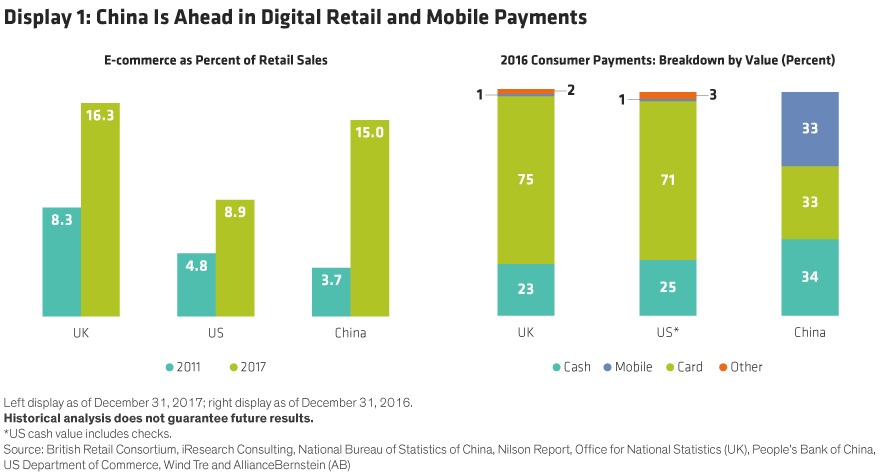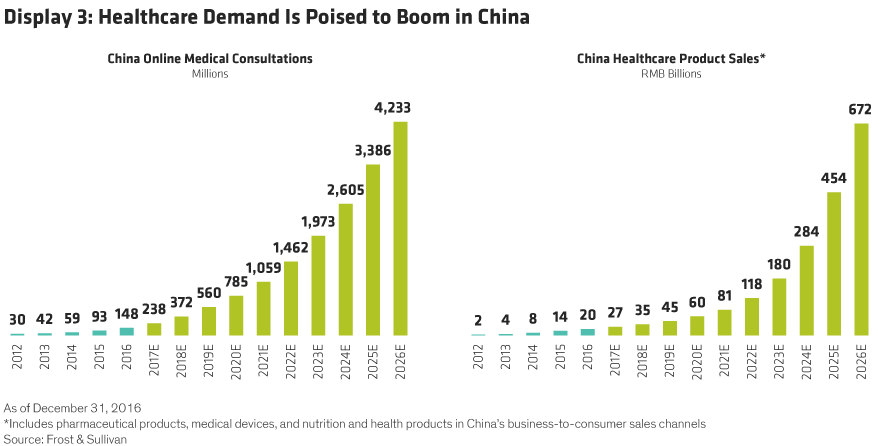In our many travels through China to explore the changing market landscape, we’ve discovered countless companies and industries that are jumping ahead of the West. These leapfroggers are creating exciting opportunities for investors as China’s equity and debt markets open to the world.
Global investors are starting to gain access to trillions of dollars’ worth of new securities in China. In June, index provider MSCI began to include domestic Chinese stocks, known as A-shares, in its emerging-market indices for the first time. Chinese authorities are adding capacity to trading programs that allow international investors to buy onshore stocks, which have an aggregate market cap of approximately US$7.0 trillion. And next April, Chinese government bonds will be added to the Bloomberg Barclays Global Aggregate Bond Index, a move that could shift an estimated US$300 billion in allocations to China’s fixed-income markets once other index providers follow Bloomberg Barclays’s lead. Foreign investor inflows into China’s bond market are already exceeding US$7 billion per month this year.
For international investors, the appeal isn’t just about the sheer size of China’s market. The Chinese equity and bond markets add significant diversification benefits to global funds. And Chinese companies are leading the way for global peers in industries ranging from e-commerce to advertising and electric cars to clean energy. Investors who can find the strongest candidates stand to benefit from powerful return potential at a time when equity markets in the developed world may lose steam.
Consumption: Chinese Consumers Come Without the Baggage
Clicks vs. Bricks
Mobile trends are at the heart of China’s technological prowess. China’s landline telephony infrastructure never developed as much as that in the US or Europe. Yet mobile phone penetration in China has almost caught up with that in the West. Meanwhile, brick-and-mortar retail is very underdeveloped in China. This difference in infrastructure is the source of China’s edge.
For developed countries, the shift to e-commerce is often painful. It requires the retail sector to unwind huge networks of stores and strike the right balance between physical and digital sales. For China, it’s much easier, since companies don’t have to dismantle nearly as much physical store space to take the digital leap. For example, the Alibaba Group has been building out its Hema supermarket chain, in which the stores are optimized for online delivery. In contrast, Amazon recently purchased Whole Foods Market and will likely need to retrofit the stores meaningfully.
What’s really going on here? Instead of reconfiguring brick-and-mortar infrastructures, Chinese companies can spend their time building efficient e-commerce platforms designed for a digital world. As a result, Chinese e-commerce now accounts for about 15% of retail sales, nearly as much as in the UK and well ahead of the US (Display 1, left). Given the vast size of the market, this translates into massive consumer power. Alibaba reported annual gross merchandise value of US$768 billion in its fiscal year ending March 2018—more than three times greater than Amazon’s over the same period.

Alibaba isn’t alone, though. Competitors include companies like JD (Jingdong), with its business-to-consumer platform that has become the e-commerce partner of Tencent, a leading Chinese Internet group. JD built up its muscle by acquiring Walmart Stores’ online business in China in 2016. The deal allowed JD to leverage Walmart’s supply chains, increase product selection and improve logistics efficiency.
Vipshop, China’s leading online discount retailer, has also been growing rapidly. By selling non-standardized clothing lines, including off-season and overstocked products of other brands, Vipshop has been able to generate higher gross profit margins than its peers.
Mobile Payments
The Chinese e-commerce boom is fueled in part by a payment revolution. Chinese consumers are far ahead of American and UK consumers in adopting mobile payment (Display 1, right). Here, too, Chinese consumers and companies have leapfrogged their world peers. And again, it’s all about infrastructures.
China has 16.3 bank branches per 100,000 adults, compared with more than 32 in the US and almost 24 in Europe. Similarly, credit cards never made it into as many Chinese wallets. This explains why Chinese consumers have embraced mobile payments for everything from clothing to fast food.
KFC (formerly known as Kentucky Fried Chicken) is a case in point. By the end of 2017, 53% of its sales in China were made with mobile payments. In fact, one premium KFC store in Hangzhou allows customers to pay using facial recognition.
Mobile payment is even popular among street vendors. For example, we’ve even seen fruit vendors on city streets with QR codes on their carts allowing payment via WeChat Pay, a popular mobile payment system operated by Tencent.
Digital Advertising Is Booming
Similar trends are evolving in media consumption. In China, the rapid shift toward mobile devices has powered a digital advertising boom. About two-thirds of all advertising spend in China is dedicated to digital platforms, compared with 40% in the US.
Televisions are no longer the centerpiece of media consumption. Today, smartphones provide advertisers with mountains of data about consumers. Returns on advertising investments can be measured more directly. And new players, equipped with more accurate data, are disrupting the way advertisers reach consumers. Through its lead in digital advertising, China is at the forefront of using consumer data as a new currency.
Technology: New Ways to Solve Tomorrow’s Problems
Education
Some Chinese companies are testing new technologies in bold ways. TAL Education uses distance learning to teach some of its students and is experimenting with artificial intelligence technology in its classrooms as well. Results from early tests suggest that these programs can keep kids more focused than real teachers. The company is also developing facial-recognition technologies to gauge the level of concentration of the students. If a student isn’t focused, parents will be automatically notified.
Megvii Technology, a Chinese facial-recognition company, is applying its technology in areas ranging from retail to security. Facial recognition is used to identify a VIP when he or she enters the store. Police applications include security cameras in shopping malls to catch criminals on the run. China is quickly turning science fiction into reality.
Environmental Challenges
At the same time, the day-to-day reality in a country of 1.4 billion people is far from simple. Rapid industrialization has created dire environmental challenges that, until recently, were not high on the country’s agenda.
That’s now changing. Since 2016, when the government signed the Paris climate accord, China has stepped up its efforts to shift its economy onto a more sustainable growth path. Dangerous levels of pollution in industrialized areas have prompted the government to act, and China’s middle class is growing increasingly intolerant.
Solar and wind power is still a relatively small piece of China’s energy market, but growth is rapidly accelerating (Display 2). Against this backdrop, China has become a world leader in the production of solar panels, led by component makers such as GCL-Poly and LONGi, which manufacture products that match up favorably with their Canadian and European competitors. Many Chinese companies that have emerged to fulfill the country’s new appetite for clean-tech and alternative energy are fast-growing, well-run operations, amply funded by both government and private sector investors.
.png?uuid=b62fb318-753f-11e8-8c12-05327b5dec5f)
Transportation
Alongside the push for renewable energy, China has embarked upon an ambitious plan to promote electric vehicles (EVs). The government sees EVs as an important component of combating its energy security problem by helping to limit oil imports and reduce pollution.
In recent years, the government has spent billions of renminbi subsidizing EV purchases and chargers, while tightening regulation of traditional fossil fuel–powered cars. Companies to watch include BYD, the world’s largest maker of electric cars and EV batteries, as well as the Chinese state-owned automaker, SAIC Motor, which launched its first EV in 2015. SAIC is seen as a pioneer in research and development and in production of electric or partially electric vehicles, and the company has a joint venture with Volkswagen and General Motors.
Healthcare: Getting into Shape
China lags the West in some areas. For example, the country’s healthcare system is still far behind the US and Europe. Yet reforms are under way that we believe will ultimately lead to major changes—and investing opportunities.
Market demand for healthcare in China is constantly growing (Display 3), owing to its large aging population. The government’s keynote reform plan—Healthy China 2030—represents a commitment to improve healthcare access and quality, raise life expectancy to 79, and support the expansion of the healthcare industry.

Regulatory changes are streamlining approval for new treatments, directly funding research and driving innovations in areas such as:
-
Cancer treatment. China may potentially leapfrog widely used chemotherapies to immunotherapies, which offer better chances for cancers to be managed or even cured in the future. Jiangsu Hengrui Medicine is a biopharmaceutical company with a rich pipeline for cancer immunotherapy treatments and other drugs for diabetes and cardiovascular diseases.
-
Artificial intelligence. This is also being applied in healthcare to facilitate disease prevention, diagnosis and patient engagement. Ping An Healthcare and Technology (also known as Ping An Good Doctor) provides online family doctors and health mall services through its mobile platform. The online healthcare platform raised US$1.1 billion via its Hong Kong IPO in May 2018.
From Discovery to Investing
From mobile technology to healthcare, China is reinventing itself—and redefining the world we live in. With innovative, technologically driven services and the largest domestic market in the world, many Chinese companies offer international investors a way to participate in China’s growth story, especially now that the onshore market is becoming more accessible.
Headlines about China’s slowing growth miss the point. Even at a slower pace, real GDP growth in China is still about 6.8%—more than double the rate of global growth. And China is transitioning away from heavy industry toward a service-oriented economy while focusing more on sustainability and the environment, backed by supply-side reform. When these trends are supported by a huge population, with a growing middle class and increasing consumer spending power, it’s clear that investors need to develop a greater understanding of how to capture opportunities in the world’s most populous nation.
Think Strategically About China
Of course, there are significant risks to investing in China. Rising debt levels have raised alarm bells. Trade tensions with the US are a growing concern. Financial information is often perceived as being unreliable. State-owned enterprises don’t always put shareholders’ interests first.
These concerns should not deflect investors’ attention from thinking strategically about China, in our view. Yet our survey of institutional investors in the US, Asia and EMEA (Europe, Middle East and Africa) suggests that more than 80% of investors don’t have a plan for investing in China.
Some of the reluctance has been caused by confusion about how to enter the Chinese market, which has been anything but simple. That’s why it’s especially important for investors to start by gaining an understanding of the different ways to access China’s equity and fixed-income markets as the landscape evolves.
Staying on the sidelines can be costly. Investors who move quickly into China’s markets today will find many new ways to profit from the explosive growth and innovation of the leapfroggers that are shaking up a wide range of global industries.
We continue to actively monitor the evolving China investing landscape to uncover investing opportunities. For more perspectives on how investors can benefit from the unfolding changes, please explore additional insights from our portfolio management teams.
The views expressed herein do not constitute research, investment advice or trade recommendations and do not necessarily represent the views of all AB portfolio-management teams.